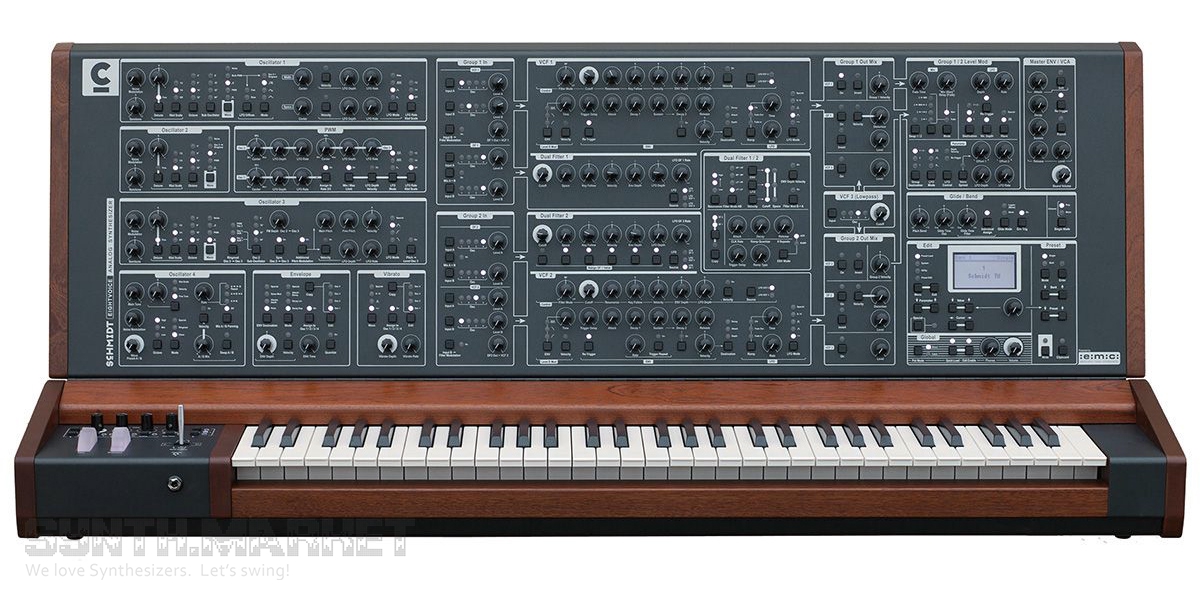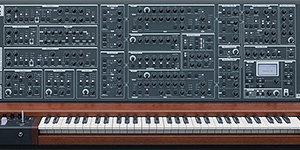Schmidt is an analog synthesizer with digital control. The analog part has a classic construction, where each voice is technically generated by a set of discrete elements, rather than a common microcircuit. To some extent, thanks to this, Schmidt Synthesizer is 8-timbral - each of its voices can be configured to be used completely independently and have a separate output. In fact, this monster of modern synthesis represents 8 monophonic synthesizers with synced or unsynced voices and separate sound paths for each voice. Of course, there are summing outputs for all voices with the possibility of independent channels for the stereo effect.
Despite the strict adherence to the traditions of the 60s, Schmidt Synthesizer has digital control and memory presets (1,028 single-programs and 256 multi-timbre ones). Given its multi-timbrality, it can replace a whole orchestra and here we see a curtsey towards such iconic synthesizers of the past as ARP Quadra. Going on with the topic of Schmidt Synthesizer relevance, we need to mention the possibility of setting and memorizing the modulation settings for each preset, full MIDI support, MIDI via USB, displaying all parameters on the LCD.
Speaking about the connectivity, we will focus on 8 (!) outputs for pedals - 4 switch and 4 expression ones, as well as separate outputs for each voice, except those that have been put into a stereo pair.
Schmidt Synthesizer interface deserves a separate description, because there are no analog synthesizers with a more detailed control. Arturia MatrixBrute took a big step in this direction, but it's just a step, and Schmidt is already on the Moon. We're not talking about the "one button per function" approach, it's just obvious. We say that each detailed function is assigned to a separate controller, for example, only the PWM control unit has 14 controllers (9 controllers, 5 buttons) and 9 separate signal indicators; both control units of VCF each have 17 controllers, 9 buttons and 20 signal indicators (by the way, all of them are multi-color diodes, i.e. even here it gets as detailed as possible). Each of the 4 generators per voice has a separate control unit with specific settings. Look at the photo of the interface and make sure that no one ever made such a comprehensive control layout. And so that your hands don’t get tired - you can always change the angle of the front panel.
For the price of$ 20,000 you will get the most heaped up analog synthesizer in the world together with the case for it, and you can be confident that its price (and value) won’t go down. Schmidt Synthesizer is released in limited series, the company receives pre-orders every few years and is a showcase unit of e: m: c - a well-known supplier of electronic components for electronic musical instruments.
An alternative... For some reason there are none. All other synthesizers are either smaller (meaning everything) and cheaper and have a different architecture (Minimoog Voyager XL, Arturia MatrixBrute, Modal 008, Prophet `08), or much more expensive (System 35), or just digital (John Bowen Synth Design Solaris, Hartmann 20). Waldorf Wave has the widest range of possibilities and unique sound, but it has long been discontinued. Believe it or not, but, in our opinion, comparing to the same money spender sophisticated Hartmann 20 Schmidt Synthesizer seems like a heavy German tank that has run into the fragile German zeppelin. Which side do you take?

















